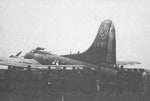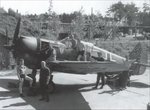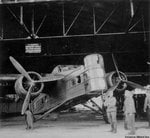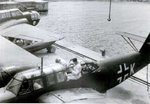War is the best testing ground for all types of fighting materiel, and this is particularly true of aircraft and their equipment. The Italian conquest of Ethiopia, the Spanish Civil War, and the Sino-Japanese conflict have all provided excellent laboratories for experiment in the design and performance of combat planes. In the present war, air power has played, and will continue to play, such an important role, that all belligerents are constantly engaged in improving their planes. Construction, speed, maneuverability, range, ceiling, armor, and fire power of aircraft are subject to daily study and change. Since World War I, the character and scope of air warfare has been revolutionized, necessitating vast improvements in design and construction. Nations have approached this problem from different angles with varying results. During peacetime, efforts were made--particularly by the Axis countries--to guard their most important air secrets from potentially hostile powers, although certain revelations could not be avoided when the aircraft were tested in actual battle experience such as the Spanish Civil War.
With the outbreak of World War II, it became vitally important for each belligerent to acquire as complete information as possible with respect to its opponents' planes in order to have the technical knowledge with which to combat them. The Germans were very late in recognizing the importance of information to be obtained from captured planes and equipment. Their plans for a lightning war did not envisage the necessity for keeping up with their opponent's technical developments. The Battle of Britain was the beginning of the lesson that showed them their error, but it was not until 6 months or so later that a formalized procedure for the salvage and examination of crashed and captured enemy aircraft began to be put into effect.
Every officer of the German Air Force who sees an enemy airplane shot down, force land, or crash in his vicinity, is required to report the incident immediately by telephone to the Air Liaison Officer at Division Headquarters, who in turn forwards the information through channels to the Luftgaukommando (German air corps district headquarters). The observing officer can telephone direct to the Luftgaukommando if such communication is available. A German Air Force officer will convey the necessary information by Air Dispatch Letter Service. The report must include identity of reporting unit and of the guard furnished, the location, nationality, and condition of the aircraft, and the location of the crew. The task of salvage is delegated by the Luftgaukommando usually to the commanding officer of the airdrome area nearest to the location of the plane; he dispatches a first salvage detachment by car. This detachment consists of an officer, a technician, a photographer, and one member of each of the communications and ordnance staffs.
At the scene of the crash, photographs are taken immediately, and the negatives sent to the Luftgaukommando photo section for examination. A preliminary technical report is then prepared for transmission to, and evaluation by, Luftgaukommando Intelligence. This report should contain a description of the plane, including data as to its position, special characteristics, construction, armament and equipment, performance, and purpose. All tactical material and personal documents of the crew should accompany the report. The member of the technical staff with the detachment will then request a salvage squad from the airdrome to complete the salvage, and this squad will include an engine specialist and additional special personnel. Salvage operations by Army or Air Force Troops are never permitted. Their duty is merely to guard the plane until the arrival of the salvage squad in order to prevent removal of any parts for souvenirs or other purposes. The flying equipment is salvaged into two groups, signal and flight data being segregated from technical material. All salvaged material is conveyed to the main Air Force station in the area, and from there to the Air Force branch concerned, except that radio equipment is dispatched via the Luftgaukommando to Chief Signal Officer, Air Ministry.
Reports by the airdrome authorities responsible for the salvage operation must immediately be made by telephone or radio to the Air Ministry and Air Staff Intelligence of the Air Force High Command in case of the signal equipment, and to the Chief Equipment Officer on the technical material. Other detailed written reports on the salvage operation, and on the plane and its equipment, are made respectively to the Luftgaukommando and the Chief Signal Officer. If there is any danger of the aircraft catching fire or being "shot up" by the enemy, all possible efforts must be made immediately to salvage equipment--particularly photographic equipment, maps, and documents--and to transmit the same to the responsible officer, together with a description of the plane from which they were taken, and the precise time and place of crash. The crew will be made prisoners of war, segregated, interrogated, and disposed of in the usual manner. Any documents in their possession are sent to Luftgaukommando Intelligence immediately.
Source: Salvage of Captured Aircraft by the German Air Force, WWII Tactical and Technical Trends, No. 16, January 14, 1943 (Lone Sentry)
With the outbreak of World War II, it became vitally important for each belligerent to acquire as complete information as possible with respect to its opponents' planes in order to have the technical knowledge with which to combat them. The Germans were very late in recognizing the importance of information to be obtained from captured planes and equipment. Their plans for a lightning war did not envisage the necessity for keeping up with their opponent's technical developments. The Battle of Britain was the beginning of the lesson that showed them their error, but it was not until 6 months or so later that a formalized procedure for the salvage and examination of crashed and captured enemy aircraft began to be put into effect.
Every officer of the German Air Force who sees an enemy airplane shot down, force land, or crash in his vicinity, is required to report the incident immediately by telephone to the Air Liaison Officer at Division Headquarters, who in turn forwards the information through channels to the Luftgaukommando (German air corps district headquarters). The observing officer can telephone direct to the Luftgaukommando if such communication is available. A German Air Force officer will convey the necessary information by Air Dispatch Letter Service. The report must include identity of reporting unit and of the guard furnished, the location, nationality, and condition of the aircraft, and the location of the crew. The task of salvage is delegated by the Luftgaukommando usually to the commanding officer of the airdrome area nearest to the location of the plane; he dispatches a first salvage detachment by car. This detachment consists of an officer, a technician, a photographer, and one member of each of the communications and ordnance staffs.
At the scene of the crash, photographs are taken immediately, and the negatives sent to the Luftgaukommando photo section for examination. A preliminary technical report is then prepared for transmission to, and evaluation by, Luftgaukommando Intelligence. This report should contain a description of the plane, including data as to its position, special characteristics, construction, armament and equipment, performance, and purpose. All tactical material and personal documents of the crew should accompany the report. The member of the technical staff with the detachment will then request a salvage squad from the airdrome to complete the salvage, and this squad will include an engine specialist and additional special personnel. Salvage operations by Army or Air Force Troops are never permitted. Their duty is merely to guard the plane until the arrival of the salvage squad in order to prevent removal of any parts for souvenirs or other purposes. The flying equipment is salvaged into two groups, signal and flight data being segregated from technical material. All salvaged material is conveyed to the main Air Force station in the area, and from there to the Air Force branch concerned, except that radio equipment is dispatched via the Luftgaukommando to Chief Signal Officer, Air Ministry.
Reports by the airdrome authorities responsible for the salvage operation must immediately be made by telephone or radio to the Air Ministry and Air Staff Intelligence of the Air Force High Command in case of the signal equipment, and to the Chief Equipment Officer on the technical material. Other detailed written reports on the salvage operation, and on the plane and its equipment, are made respectively to the Luftgaukommando and the Chief Signal Officer. If there is any danger of the aircraft catching fire or being "shot up" by the enemy, all possible efforts must be made immediately to salvage equipment--particularly photographic equipment, maps, and documents--and to transmit the same to the responsible officer, together with a description of the plane from which they were taken, and the precise time and place of crash. The crew will be made prisoners of war, segregated, interrogated, and disposed of in the usual manner. Any documents in their possession are sent to Luftgaukommando Intelligence immediately.
Source: Salvage of Captured Aircraft by the German Air Force, WWII Tactical and Technical Trends, No. 16, January 14, 1943 (Lone Sentry)




























































